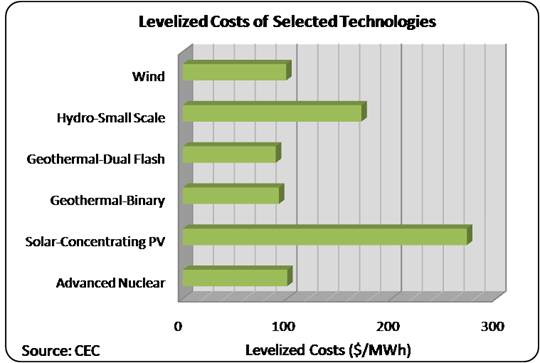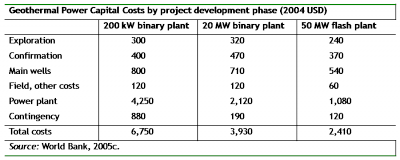The cost of developing a geothermal power plant is often comparable to a conventional fuel plant. The cost of a geothermal plant is largely in the construction of the plant and the scouting of the site. On the other hand, it requires little upkeep to produce electricity efficiently. Most geothermal power plants can run at greater than 90% availability (operating more than 90% of the time), and can even run up to 98% availability. This can have the downside of increased maintenance costs. The run time must be balanced with the current price of electricity for the plant to be economically viable. After the initial cost of establishing a plant, the electricity can be sold for a large profit compared to other sources.

Levelized Energy Cost is the price at which electricity must be generated from a specific source to break even over the lifetime of the project
Scouting for a prospective site and confirming that the geothermal resource is viable makes up a large portion of the start-up costs for a geothermal plant. Wells are drilled to confirm the source and pipeline construction can begin before the plant is constructed. The extensive testing makes it viable to begin constructing infrastructure before final resource analysis. While this is happening, plans for the plant are developed to fit the specific site, and construction begins after final analysis. An analysis of plant costs is shown below.
The high initial cost for the site and power plant is offset by the very low maintenance and operation costs which often range from $0.01 to $0.03 per kWh. The cost of geothermal electricity also does not fluctuate with the supply and demand of fossil fuels. This results in a cheap and stable electricity source.
Geothermal electricity production has been increasing in the U.S. ever since its widespread inception in the early 1970s. The increase plateaued for a period of around 10 years from 1995-2005. Recently, The technology has again began a steady rise in implementation and will likely continue to do so. As of 2013, there around 1,000 MW of planned geothermal projects. With an increasing demand for renewable energy, geothermal may see a surge in development as it begins to compete with fossil fuel plants.
A very detailed analysis of the current economic state of geothermal electricity generation by the Geothermal Energy Association can be found in their 2014 Annual U.S. & Global Geothermal Power Production Report.
Primary Author: Andrew Leuschner
Edited by: Kyle Brennan
Citations
2014 Annual U.S. & Global Geothermal Power Production Report. (n.d.). . Retrieved May 4, 2014, from http://geo-energy.org/events/2014%20Annual%20US%20&%20Global%20Geothermal%20Power%20Production%20Report%20Final.pdf
Geothermal Basics – Power Plant Costs. (n.d.). Geothermal Basics – Power Plant Costs. Retrieved May 6, 2014, from http://www.geo-energy.org/geo_basics_plant_cost.aspx
Nyberg, M. (n.d.). Electric Generation Capacity & Energy. Electric Generation Capacity. Retrieved May 6, 2014, from http://energyalmanac.ca.gov/electricity/electric_generation_capacity.html
Title 20, Chapter 4, Article 7. Regulations for the Geothermal Grant and Loan Program . (n.d.). . Retrieved May 4, 2014, from http://www.energy.ca.gov/geothermal/grda_rulemaking/documents/grda_regulations_2014.pdf


